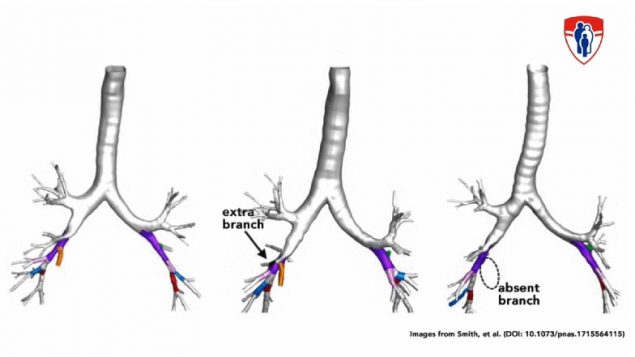In turns out that lungs are not as simple as what TV commercials and textbooks would have us believe.
New research has shown that about a quarter of the population has variations that may result in breathing problems later in life which can become serious and even cause death.
Dr Benjamin Smith (MD. MSc, FRCPC) is with the Research Institute of the McGill University Health Centre.
ListenThe new study involved finding people with the variations and conducting interviews into health problems along with actual breathing tests and measurements.
The variations they discovered involved people with an extra branch in the lung tree, or people without one of the “normal” branches.

IMAGE: RI-MUHC
What they found was that people with these conditions were more likely to develop Chronic Obstructive Pulmonary Disease (COPD)
The study, titled “Human Airway Branch Variation and Chronic Obstructive Pulmonary Disease,” was published Jan. 16 ahead of print in Proceedings of the National Academy of Sciences. (abstract HERE)
What is not commonly realized is that COPD is one of the leading causes of death around the world.

The discovery of these variations by Dr Smith (left) and other scientists at the Research Institute of the MUHC and at Columbia University Medical Center (CUMC) could help clinicians personalise treatments for patients in the future. PHOTO: RI-MUHC
What the researchers suspect, and will continue to research is whether this variation in one of the larger branches is indicative of a replication of the variation further down into the smaller and smaller branches.
Dr Smith points out that those with the variation are not automatically going to develop breathing problems or COPD, but simply that the odds are increased of developing a problem.
They found that those with an extra airway branch were 40 percent more likely to have COPD than people with standard anatomy. People missing a specific airway branch were almost twice as likely to have COPD, but only if they smoked. The findings were replicated in a second study of almost 3,000 patients with and without COPD.

Researchers suspect that a variation in a large branch is likely repeated into the increasingly smaller branches potentially exacerbating future breathing problems PHOTO: RI-MUHC
Dr Smith says the single most important thing people can do to reduce the risk of COPD is to stop smoking.
He says these findings are leading to a new area of research in COPD and potential treatments.
Financial support for the research was provided by the National Institutes of Health, rhe Research Institute of the McGill University Health Centre (RI-MUHC), and the Fonds de recherche du Québec – Santé (FRQS).







For reasons beyond our control, and for an undetermined period of time, our comment section is now closed. However, our social networks remain open to your contributions.